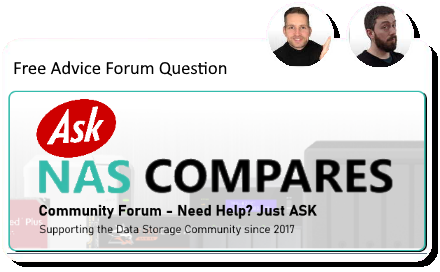
+- ASK NC (https://ask.nascompares.com)
+-- Forum: Q&A (https://ask.nascompares.com/forumdisplay.php?fid=1)
+--- Forum: Before you buy Q&A (https://ask.nascompares.com/forumdisplay.php?fid=2)
+--- Thread: overwhelmed (/showthread.php?tid=12322)
overwhelmed - Enquiries - 09-16-2025
I'm feeling a little overwhelmed by all of the options for a NAS.
I'm a freelance video editor. I've used G RAID drives in the past, but one just failed. Currently it's a RAID 10 setup at 18TB and I've been using smaller SSDs since. I am considering getting more SSDs and just backing up projects to dropbox when finished with them, or getting a NAS setup, but unsure which route to take. Any advice is much appreciated on which setup would work good for my situation.
I don't love the clunkyness of a big NAS station taking up space in my office, and for when I need to go on the road. But I'm open to options. I edit on a macbook pro, and have a caldigit hub to connect everything to.
I've seen SSD NAS setups, but don't know if that's a better option than spinning drives. I just need a solid solution moving forward.
Nic
RE: overwhelmed - ed - 09-16-2025
Totally understandable to feel overwhelmed — once you move beyond simple RAID drives, the options really open up. Given your workflow, there are two main paths to consider.
If portability and simplicity are the priority, you can stick with external SSDs for live projects and then back up completed work to Dropbox or to a large external RAID. This keeps your desk footprint small and travel-friendly, but it does mean you’re juggling multiple drives and you don’t get centralized, always-on storage.
If you go the NAS route, you gain a central hub for projects, backups, and expansion, plus the ability to work directly off it in your office. For your budget and capacity target, something like the Synology DS1825+ or the QNAP TVS-h874 would make sense. Both give you 8 bays to start, room to expand, and strong support for creative workflows. You’d fill those with NAS-rated HDDs (say 8 x 12TB Seagate IronWolf or WD Red Pro in RAID 6), which gets you around 72TB usable. That gives the large, reliable archive you’re missing today. For active editing, you can add SSD cache or a small SSD volume inside the NAS, or keep using external NVMe drives as a scratch space for your current project and then offload to the NAS once done. That hybrid model is what many video editors end up doing — fast SSDs for the live cut, HDD NAS for the library.
On SSD-only NAS setups: they’re fast, quiet, and compact, but they get very expensive once you scale past a few terabytes. To reach 80TB+, you’d need enterprise QLC SSDs, which would blow past the $2,000 budget quickly. Right now, HDD-based NAS with a touch of SSD caching is the sweet spot.
For your MacBook Pro and Caldigit hub, you can connect the NAS via 10GbE (many Caldigit hubs support 10GbE adapters) and get speeds high enough for multiple 4K streams straight from the NAS. That keeps everything central, backed up, and expandable.
If you’d like to see options, here’s the IronWolf Pro line that scales to 24TB per drive: https://www.amazon.com/s?k=Seagate+IronWolf+Pro+24TB&linkCode=ll2&tag=dbite_yt-20
So, the choice comes down to portability vs centralization. If you travel heavily, stick with external SSDs and cloud/archive for finished work. If most of your editing happens in your office, a NAS will pay for itself in saved time, capacity, and peace of mind.